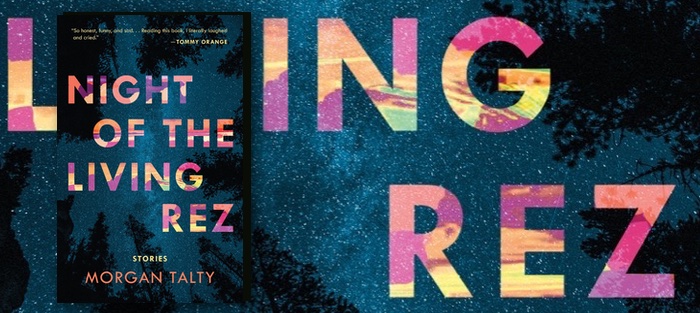Morgan Talty’s linked story collection, Night of the Living Rez (Tin House Books), isn’t out until July, but it’s already garnered critical acclaim, including several well-meaning comparisons to Denis Johnson’s Jesus’ Son. Comparisons can be problematic—particularly when an iconic white writer is held as the ultimate aspiration. And doing so dismisses how singular Talty’s voice is. The twelve stories in Night of the Living Rez are masterfully rendered, demanding to be read, then read again.
The collection opens with “Burn.” Dee, the book’s Penobscot protagonist (who goes by David when he’s younger), returns to the rez after failing to trick his dealer into getting him high, and finds a friend whose braids are frozen into the snow. It’s the shortest story in the collection, one that merely gives a glimpse of these characters, yet is arguably the perfect way to open the book, setting the tone and establishing elements of Dee’s life on the rez. He notes, “everything we needed—except pot—was on the rez. Well, except Best Buy or Bed Bath & Beyond, but those Natives who bought 4K Ultra DVDs or fresh white doilies had cars, wouldn’t be taking the bus like me or Fellis did each day to the methadone clinic.” There’s so much packed into those (and subsequent) sentences that tell us about Dee and his perceptions of life on the reservation.
The Penobscot Indian Nation is one of the over 570+ federally recognized tribes (though, let’s not forget there are many others without legal recognition). An author’s note explains that while the Penobscot language was historically an oral language (an alphabet and spelling system were later adopted), Talty has chosen to phonetically spell the words as a representation of his own knowledge of the language, as well as to make it more accessible to readers. And while Talty has clearly considered accessibility in his work, because of the lack of Penobscot representation in mainstream literature, it’s wise for non-Native readers to be careful in interpreting it as a definitive portrait of this tribe. Far better to read it as it’s intended: as a beautiful and brutal portrait of one Penobscot boy, his family, and friends.
 These stories also move through and across time, offering portraits of Dee as a child, teen, and adult. In the second story, “In a Jar,” we meet Dee when he’s younger, and he and his mother are moving to the rez, without his older sister. Of all the stories, this one takes place the earliest chronologically, and while the fallout from its major conflict is alluded to in subsequent stories, we don’t see it directly until the collection’s final story, “The Name Means Thunder.” The careful construction of the order of the stories is one of the stylistic choices that make Night of the Living Rez so compelling. Encapsulating the collection with the last story has a powerful effect, and upon finishing, one may find oneself wanting to immediately reread the book again in its entirety.
These stories also move through and across time, offering portraits of Dee as a child, teen, and adult. In the second story, “In a Jar,” we meet Dee when he’s younger, and he and his mother are moving to the rez, without his older sister. Of all the stories, this one takes place the earliest chronologically, and while the fallout from its major conflict is alluded to in subsequent stories, we don’t see it directly until the collection’s final story, “The Name Means Thunder.” The careful construction of the order of the stories is one of the stylistic choices that make Night of the Living Rez so compelling. Encapsulating the collection with the last story has a powerful effect, and upon finishing, one may find oneself wanting to immediately reread the book again in its entirety.
The impulse to return to this work is because there’s much to admire on a craft level. Not just sentences, though readers who underline passages they love will easily mark up the text. All the story elements are in conjunction with one another. The architecture of these stories is that of someone who intimately and expertly understands short fiction, which arguably utilizes additional skills than longer form—compression and endings that are poetically poignant.
The recurring themes and imagery emerge subtly, and are never overstated. Smoke is an image we see repeatedly, though the context or meaning changes. In “The Blessing Tobacco,” David is pretending to be the younger brother of his grandmother (who has Alzheimer’s), and smokes dozens of cigarettes with her, only to get very ill. But in “Smokes Last,” he’s seeking cigarettes, like his mother does in “Safe Harbor.” And as the collection’s title suggests, there is a motif of dying and decaying—such as a hidden dead snapping turtle and a road “boiled with caterpillars”—and things and people perceived to be dead sometimes come back to life. Or, more often, the trauma of such loss is continuously carried, even reviving and reemerging. These stories wrestle with what it means to survive—living and persevering after tragedy. And the characters, like all of us, must figure out when and how to prioritize individual needs versus that of others: “I had the fucking question all wrong. It had nothing to do with us. It had everything to do with me. How did I get here, and how do I get out?”
Another theme is the construction and telling of stories, how they’re passed down—or not—and how they get revised. At one point David says, “I tried to listen to how she told the story—because how it was told mattered.” And this idea of how a story is told plays into the larger theme of survival: we often need to rewrite our stories of tragedy and trauma to move forward. Sometimes this is the lie we tell ourselves or others, or it can be how we try to forget our personal history, often through drugs or alcohol. And throughout the collection we witness characters often medicating as a way to cope with their pasts.
In this way, it’s easy to see comparisons to Jesus’ Son based on subject matter. And perhaps the heart of the comparison is how Johnson is what many call a “writer’s writer”—someone whose skills on the page are a marvel to other writers. Because Talty is arguably one, too. Night of the Living Rez is an impressive debut filled with brilliant stories to revisit.






